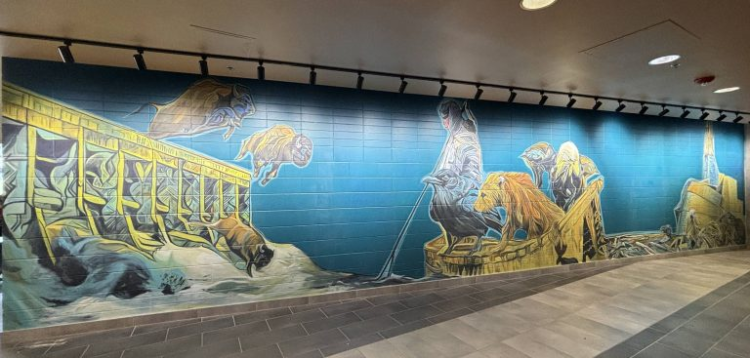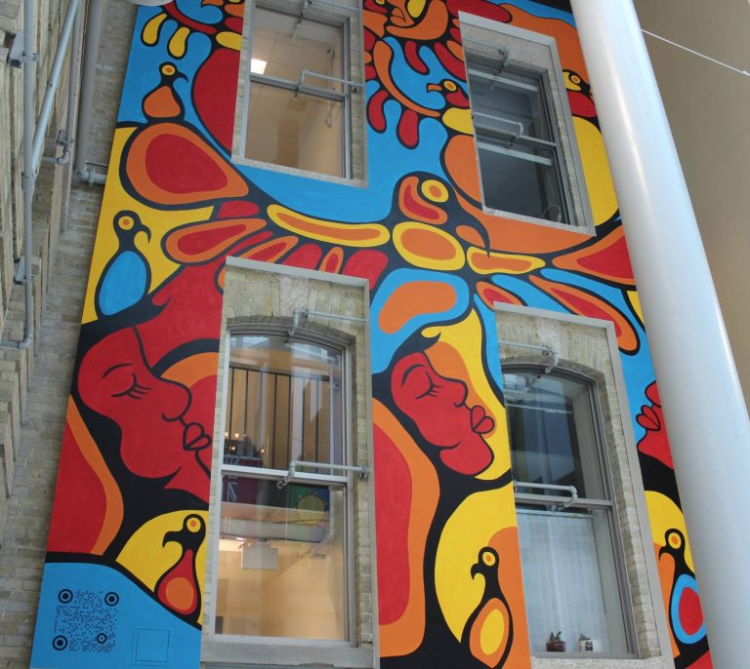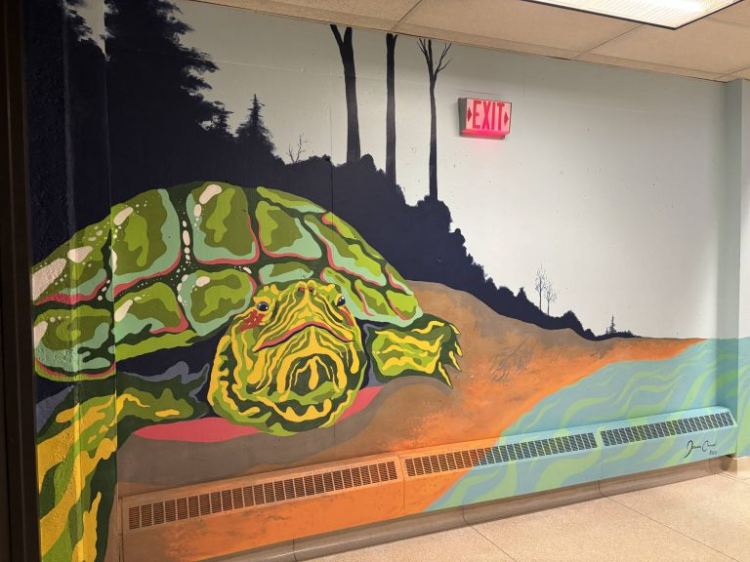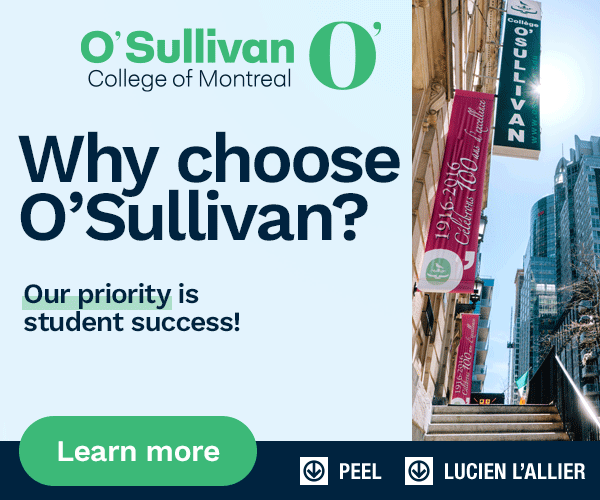The largest classroom at UM is yours to explore. From tunnels and hallways to gathering spaces, Indigenous artists bring colour and meaning to the everyday spaces students, staff, faculty and visitors move through.
Newest mural decorates student residence
The newest mural appears in Pembina Hall student residence, freehand painted by Ojibway artist, Jackie Traverse [BFA/09].
Set in a high-traffic hallway where hundreds of students pass through daily, it's a bold and beautiful sight for those who've come from around the world, calling student residence their home away from home.
Titled "The Courage to Walk Your Own Path", Traverse's piece draws on one of the Seven Sacred Teachings, courage, echoing the bravery of every student carving their journey far from home.
After five hours of free-hand painting, the once-blank wall now radiates energy to all who pass by.
More to explore
This piece does not stand alone. If you've wandered through the Fort Garry or Bannatyne campuses, you've likely seen other bold and impressive artworks brightening shared spaces.
These murals tell stories through symbolism and intricate details, shaped by each artist's community, lived experiences and unique artistic style.
They reflect Indigenous ways of knowing, being and doing offering familiarity and connection, and inviting reflection and curiosity.
Truth and Reconciliation and Engineering

Just outside the Dean's Office in the Price Faculty of Engineering, a 9 x 40 ft mural by local Métis artist, Mike Valcourt, sparks dialogue through art.
The mural honours the understanding that Indigenous Peoples were the first engineers, illustrating how innovation has always been tied to Indigenous knowledge systems and deep relationships with land.
"We are aware that some industries have had a greater impact on Indigenous communities than others, and the engineering department acknowledges its role in this. By reminding the academic community of the resilience and voices of Indigenous peoples, this work promotes dialogue and introspection. It's a nod to the past, and a promise to the future." - Mike Valcourt
Indigenous health principles

In the Active Living Centre, a vibrant mural by Kristin Flattery, Ozhaawashkwaa Mashkode-Bizhiki (Blue Buffalo Womyn) [BFA(Hons)/17, BEd/20] centers Indigenous knowledge systems.
The mural is a visual re-telling of an Indigenous creation story passed down in Ininew (Cree), Anishinaabe (Ojibway) and Oyate (Dakota) cultures through oral traditions.
The Anishinaabe-Oyate artist depicts a holistic understanding of health in her mural one that includes spirituality, relationships and the environment aspects often overlooked in Western approaches to wellness.
"We wanted to create something that inspired a movement in healthy living for everybody, so not only was I trying to promote healthy living and insert our traditional knowledge I want (the community) to be motivated toward teamwork and helping each other." - Kristin Flattery
Indigenous youth rise
At the Brodie Centre Atrium on the Bannatyne campus, a mural by Anishinaabe artist Blake Angeconeb, member of Lac Seul First Nation, anchors the heart of the Rady Faculty of Health Sciences.

Colourful and symbolic, the mural tells a story of little birds beginning their journeys at the bottom. Centered above them is a thunderbird with outstretched wings offering guidance.
Three face figures represent everyone, and smaller thunderbirds soar across the top symbolizing teachings, growth and our individual journeys.
Honouring truth, legal traditions and belonging
In the Faculty of Law, Anishinaabe artist and second-year law student Jessie Canard painted a mural titled "Turtle Island" outside the Manitoba Indigenous Law Students' Association (MILSA) office.

The mural depicts the turtle from the Seven Sacred Grandfather teachings, embodying the importance of truth, grounded in Indigenous legal traditions.
This piece is one of four murals greeting you as you enter the MILSA office. The other three are representative of Inuit, Métis and First Nations cultures. Canard hopes her art reminds students of where they come from, helping guide them during their law school journey.
Connections, community and collaborative spirit

Outdoors, the UMCycle building is decorated with vibrant artwork by Ojibwe artist and a member of Skownan First Nation, Dee Barsy [BFA/08] and Métis artist, Kenneth Lavallee [BFA/08], created in collaboration with Elders and community leaders from Migizii Agamik.
The piece reflects themes of movement and connections to land and water, using bold colours and incorporating the medicine wheel.
Both artists emphasized the importance of community involvement and hope the mural inspires more collaborative projects on campus.
Brightening campus and sharing stories
As more students, staff, faculty and visitors encounter these murals and designs, the campus grows into a place where art teaches, reclaims and connects.
They carry meaning that goes beyond aesthetics, inviting everyone on campus to engage with Indigenous art and worldviews in ways that are accessible, lasting and contribute to a sense of belonging.
More Indigenous art across campus:
- New student lounge, mural bring sense of belonging' to Indigenous nursing students
- New mural connecting Indigenous knowledges and The Centre for the Advancement of Teaching and Learning: Hoops for now' featured at the Centre for the Advancement of Teaching and Learning at 65 Dafoe Road
- For those willing to travel by a different route' Indigenous Art and Placemaking signs come to Fort Garry campus
- A flurry of underground colour













